HISTORY
since1903
Here we will introduce the history of Utsunomiya Seisaku and its founder Usaku Utsunomiya from the time of the company's establishment to the present.
The history of Utsunomiya Seisaku, which spans over a century, has been a story of keeping true to the company's original will while responding to the drastic changes that society has undergone over the years.
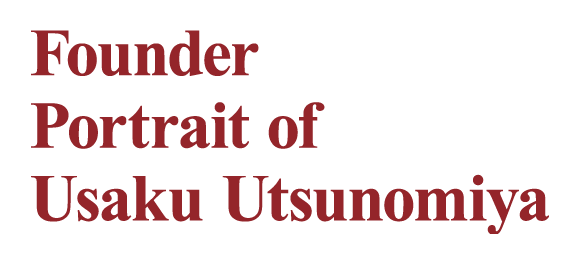
Japan's major founding period
In 1903, the same year that the Wright Brothers accomplished the world's first piloted flight in North Carolina, USA, Utsunomiya Seisaku was founded at Osaka's docks as Utsunomiya Shouten, selling medical-use products and rubber-made products. At the time, while Japan had just opened up the country and started to formalize importation from western civilizations, sparking an industrial revolution, the country had not yet achieved domestic production that could compete with imports from Europe and America. In order to protect Japan from the allied western powers, who were trying to colonize the various countries of Asia, the Meiji Government began putting efforts into matching the power of these western countries by pushing for the development of national prosperity and defense, gradually moving towards imperialism that strengthened the country through its military power. After two consecutive victories in the First Sino-Japanese War in 1894 and the Russo-Japanese War in 1904, Japan had built up an international rank, which allowed the country to quickly progress in their domestic production. The events of this period led to a significant revolutionary wave for the shops on the docks of Osaka, which were the core of Osaka's commerce ever since the Edo Period. This period is considered to be an historic period of the founding of many large Japanese corporations that represent Japan even to this day.
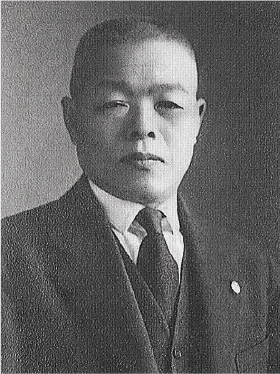
Founding and First President (1903 - 1943)Usaku Utsunomiya
- October 10th, 1882:Born in Iwakimura, Higashiuwa District, Ehime (current day Uwacho Seiyo).
- 1903: Opens Utsunomiya Shouten (current day Utsunomiya Seisaku)
- 1932: Receives the Medal with Dark Blue Ribbon
- 1935: Becomes the first Union President of the Osaka Medical Product Wholesaler Association April 8th, 1950: Dies at the age of 67
The Life of Usaku Utsunomiya
During an era when Japan relied on foreign imports for most medical products, he devoted his life to self-sufficiently developing products.
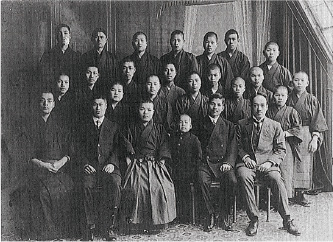
Employees at the time of the opening of Utsunomiya Shouten
Usaku Utsunomiya was born on October 10th, 1882 in Iwagi, Higashiuwa District, Ehime (current day Uwacho Seiyo) as the fourth son of Gijuro Utsunomiya. After graduating from Iwagi Elementary School, he moved to Osaka on his own and began working as an apprentice at Miyoshi Shouten, a medical equipment shop located at the docks of Osaka. In 1902, he became emancipated, and after affably leaving Miyoshi Shouten, in 1903, he founded Utsunomiya Shouten at 5 chome Hiranomachi, Higashi Ward (current day 4 Chome Awajimachi Chuo Ward). He was only 20 at the time.
Initially, he intended to become a stethoscope manufacturer, during a time when the country relied on imports from Europe for most medical products, it was a difficult task to independently develop medical products, so the company's core sales came from medical-use rubber products. The product that Usaku particularly devoted himself to was the "water pillow". Utsunomiya Shouten became widely known when he developed and sold the revolutionary "framed shimegi". This invention is still used on water pillows to this day.
During the 40 years until he eventually retired as president in 1943, it can be said that the numerous patents and utility models acquired were the manifestation of Usaku's will to devote his life to research and development.
On April 8th, 1950, Usaku Utsunomiya passed away at the age of 67.
Usaku during his apprenticeship
He self-taught himself reading, writing and arithmetic, and learned foreign languages "on the toilet".
During Usaku's youth, when he graduated elementary school, it was common for him to work his contacts and serve apprenticeships. Apprenticeships at that time were significantly different from employment today. Apprentices would, at no cost, live at the shop that hired them and would be paid only a small amount of money. They would work from 6AM when they woke up until 10PM when they went to sleep, carrying out chores such as cleaning and running errands, only getting a day off on New Year's Day and during Festivals. During these days, he gained practical knowledge in trade, going from apprentice to sales clerk to head clerk, and then finally to owning his own shop. Furthermore, if it weren't for the fact that during these busy days he taught himself the necessary reading, writing and arithmetic for trade purposes and attained foreign language abilities, he would not have been able to become a medical equipment shop that handles imported goods. According to his descendants, "he would read books on the toilet."
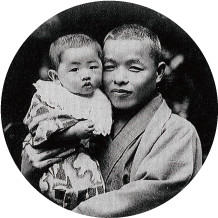
Usaku Utsunomiya during his youth
Usaku Utsunomiya's personality
He addressed his workers with the honorific "-san" and never directly scolded his younger workers.
Usaku Utsunomiya was dependable and modest in everything that he did, and while it is said that he never strayed from his matter-of-fact attitude toward life, he had a relatively high-pitched voice and was even sometimes difficult to understand with his slow, quiet way of speaking. Furthermore, besides the side of him that was shy and didn't like taking pictures, he liked new things. In fact, in June of 1925, as soon as Osaka had their first broadcast station, he bought a radio and he would use his connections through the company to buy new imported products like phonographs, washing machines, refrigerator, vacuums, electric heaters, etc.
He was very considerate of his employees. As he knew that his presence would make his employees nervous, he always waited until 1 minute after the starting time of 8AM before he would make an appearance. He addressed his workers with the honorific "-san" and would always be careful when calling the more senior employees.
Utsunomiya Commercial Law
Lessons that placed importance on thrift and saving that exemplified Usaku Utsunomiya's view of life
- Customers are not only those who buy the products, it's also those who sell them.
- Do not do business that is above your own power.
- Always make your sales average out over the year.
- If your sales drop even a little bit, try to adjust your expenses to match.
- Always have next month's payment prepared this month.
This was Usaku Utsunomiya's way of doing business that he always preached to his employees. These are the lessons that embody the life perspective of the Usaku that was born in a poor village in Shikoku. He was all about thrift and saving, often saying things like "Having fun is alright, but let's consider income while we have fun too" or "Put away half of your money to save for a house. If you do that then I'll take care of the rest."
Harbor Life of Utsunomiya Shouten
Placing importance on the aspirations of youth, Utsunomiya Shouten encouraged its young employees to go to night school and even paid the monthly fee for them.
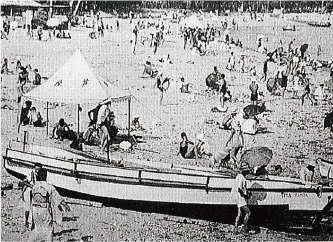
Ashiya Beach during the Early Showa Period
At the time, Utsunomiya Shouten had a boarding system and single employees were not allowed to commute to work. Not only that, after joining the company they were not allowed to return to their home for the first 4 years of employment. While this system was very strict, perhaps this was a form of parental love that Usaku had for his employees in order to cultivate an independent spirit as a tradesperson. Because Usaku had experience with the struggle of studying on his own, he placed importance on the aspirations of his young employees. He encouraged them to go to night school and even paid the monthly fee for them.
Furthermore, there was a study room in the dormitory where each person was provided their own desk with which they could study and read. During the early Showa period, a time when there was a terrible food situation, there was a dining hall in the dormitory where employees could have as much food as they wanted at meals. The company took care of its employees' health, providing single employees with three meals, and married employees with lunch. There was even a club called the "Let's Walk" club at Utsunomiya Shouten that all new employees had to join. They met once a month to go hiking, where outdoor clothing, a hunting cap, and leather shoes were provided. Moreover, in summer, they built a home by the ocean in Ashiya and with a 3-shift alternating system, they would go to swimming in the ocean two days at a time.
Perhaps Usaku, who experienced a strict apprenticeship himself, felt it was important for his young employees to lead a fun and fulfilling lifestyle.
Two monuments at his birthplace
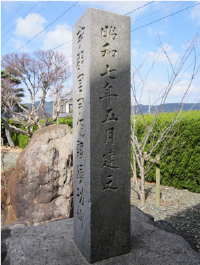
Monument at Sekijo Elementary School
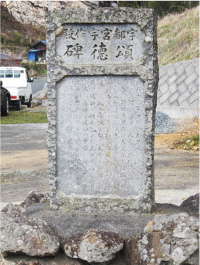
Usaku Monument at Kawachi Pond commemorating him for his reconstruction support
Usaku Utsunomiya's birthplace of Uwacho Seiyo, Ehime, located between Yawatahama, Ozu, and Uwajima, is a farm belt at the center of Nanyo Region's traffic. At Kasagi Pass, from which you can get a view of Kyushu, there is Kasagi Pass Tumulus, a large keyhole-shaped tomb from the first half of the 4th century. Kasagi Pass is where Japan's first female doctor, Kusumoto Ine, learned Dutch and Western medicine from Ninomiya Keisaku.
Around Uwajima, there are still many people with the last name Utsunomiya. It is theorized that the origin of the Utsunomiya family in Uwajima came from the end of the Heian Period until the Early Kamakura Period, when Iyo Province (current day Ehime Prefecture) protector Utsunomiya Yoritsuna (1172-1259), who hailed from the hometown of the Utsunomiya family (Utsunomiya, Tochigi Prefecture), expanded his influence in this area.
In the compilation of beautiful scenic photographs of Uwacho known as "The Four Seasons of UWA", there are records related to Usaku Utsunomiya. It is believed that the area where Usaku Utsunomiya's family's home was located is seen in a scenic photo named "Iwagi no Tairetsu".
What is particularly remarkable is that in Uwacho there are two monuments praising the achievements of Usaku that are still there today.
One of those monuments is located at Sekijo Elementary School. To commemorate Usaku, who donated money to pay for a new auditorium and contributed a large scholarship to Sejiko Elementary School, they built this monument.
Furthermore, in 1943, an alluvial pond broke down, causing flood damage and even causing the domestic carp that were in the pond to be washed away (even ruining the rice paddy fields). In response, Usaku, who was in Osaka at the time, swiftly came in with resolve and donated his worldly possessions in order to control the flood. Since this was during the war, male labor was scarce and efforts to restore the pond were driven by women as well as elderly folks and children, who were so grateful for Usaku's support that they built a monument for Usaku next to the pond.
- 1903
- Usaku Ut sunomiya founds Utsunomiya Shoten store, which handles medical supplies.
- 1911
- Transactions with Dunlop Far East begin.
Becomes exclusive distributor of medical rubber products in the Far East. - 1918
- Commercial introduction of the Right Water Pillow, the original model of modern water pillows
- 1919
- Initiated imports of clinical thermometers from Germany
- 1927
- Expanded sales networks from Tokyo to Kyushu in Japan and to Taiwan, Korea, and China overseas
- 1928
- Concluded exclusive distributorship agreement with Dunlop Far East to sell seamless water pillows
- 1935
- Incorporated as Utsunomiya Shoten Co., Ltd.
- 1940
- Merged with/absorbs Dunlop Medical Rubber Sales.
- 1943
- Renamed Utsunomiya Seisaku Co., Ltd.
- 1946
- Launch of Right Clinical Thermometers
- 1947
- Established Engineering Product Division; first sales of industrial rubber products
- 1949
- Becomes exclusive distributor of Dunlop in Japan after the war.
- 1954
- Commercial introduction of Vinylite (vinyl light PVC) gloves
- 1964
- Opens Tokyo branch.
- 1971
- Capitalization increased to 30 million yen
- 1978
- Capitalization increased to 50 million yen
- 1982
- Launch of THOMA Plastic disposable gloves
- 1984
- Launch of Two-Way switching resin cocks
- 1985
- Start of production of powder-free plastic gloves
- 1986
- Opening of Fukuoka Sales Office; commercial introduction of SINGER Denshaku Bo caps, which keep hair out of food and workspaces
- 1988
- Obtained JAN code to print bar codes on major products
- 1991
- Launch of Three-Way switching cocks
- 1996
- Head office relocated to Higashiosaka-shi, integrating administrative and sales organizations; CI undertaken.
Promulgated new company emblem and logo. Obtained utility model patent for UT-2 Structure, switching cocks (flowing water switching device), and patent for UT-3 Structure. - 1999
- Established the International Product Department to actively explore overseas products
- 2000
- Nursing care product department spun off to establish Kurashi ikiiki Co., Ltd. (“a happy and fulfilling life”)
- 2003
- Ceremony commemorating Company’s centennial
- 2004
- Obtained ISO 14001 certification
- 2005
- Obtained ISO 9001 certification
- 2006
- Tokyo Sales Office renamed the Tokyo Branch as operations expand. Capitalization increased to 90 million yen by investment from Osaka Small and Medium Business Investment & Consultation Co., Ltd.
- 2009
- Fukuoka Sales Office renamed the Fukuoka Branch.; Integrated Kurashi ikiiki Co., Ltd.; Established Utsunomiya Holdings Co.,Ltd.
- 2010
- Fukuoka Branch relocated as operations expand
- 2013
- Ceremony commemorating 110th anniversary of the Company’s founding; established the Mamoruwo tsukuru! concept message; Kenji Onishi receives Health, Labour and Welfare Minister’s award for contribution to medical affairs.
- 2014
- Integrated ISO14001 into ISO9001
- 2015
- Launch of the new Pro+ product line
- 2017
- Head office relocated to Chuo-ku, Osaka-shi, as operations continue to expand; former head office renamed the Higashiosaka Monozukuri (craftsmanship) Center.
Obtained ISO 13485:2016 Certification - 2019
- Announcement of the Health Declaration
- 2020
- Announcement of the Environmental Declaration
Certified the Health and Productivity Management Organization Recognition Program - 2021
- Established Utsunomiya Seisaku Museum in Higashiosaka Monozukuri Center
Utsunomiya Seisaku Utsunomiya Museum of Art Opened - 2022
- Announcement of the Declaration of Human Rights
Accreditation of Company Labor Diagnostic Certification by the Labor and Social Security Attorney
